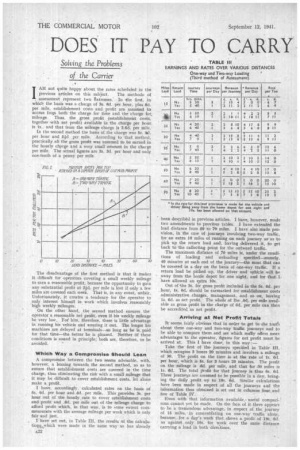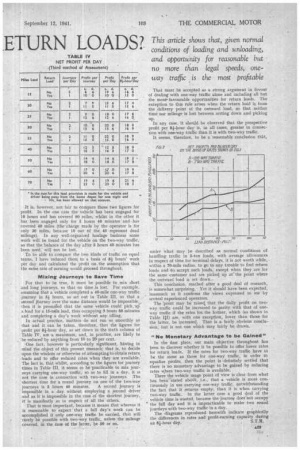DOES IT PAY TO CARRY ETURN LOADS?
Page 24

Page 25

If you've noticed an error in this article please click here to report it so we can fix it.
JAM not quite happy about the rates scheduled in the
previous articles on this subject. The methodsof , assessment represent two txtremes; In the first, in which the basis was a charge of 3s. 6d. per hour, plus 8d. per mile, establishment costs and profit are assumed to accrue frop both the charge for time and the charge for, mileage Thus, the gross profit (establishment costs, together with net profit) available in the charge per hour, is Is., and that from the mileage charge is 2.6d. per mile.
In the second method the basis of the charge was 5s. 9d. per hour and 50 per mile. According to that method, practically all the gross profit was assumed to be earned in the hourly charge and a very small amount in the charge per mile. The actual figures are 3s. 3d. per hour and only one-tenth of a penny per mile.
The disadvantage of the first method is that it makes it difficult for operators covering a small weekly mileage to earn a reasonable profit, because the opportunity to gaia any substantial profit at 2id, per mile is lost if only a few miles are covered each week. That is, in any event, unfair. Unfortunately, it creates a tendency for the operator to only interest himself in work which involves reasonably
'high weekly mileages. • On the other hand, the second method ensures the operator a reasonable net profit, even if his weekly mileage be very low. Fof him, therefore, there is little advantage in running his vehicle and wearing it out. The longer his machines are delayed at terminals-so long as he is. paid for that time-the better he is pleased. Neither of these conditions is sound in principle; both are, therefore, to be avoided.
Which Way a Compromise Should Lean
A compromise between the two seems advisable, with, however, a leaning towards the second method, so as to ensure that establishment costs are covered in the time charge, thus eliminating the risk with a small mileage that it may be difficult to cover establishment costs, let alone make a profit.
I have, accordingly, calculated rates on the basis of 5s. 6d. per hoar and 6d. per mile. This provides 3s. per hour out of the hourly rate to cover establishment costs and profit and .6d. per mile out of the mileage charge to afford profit which, in that way, is to some extent commensurate with the average mileage per week which is only fair and just.
I have set out, in Table III, the results of the calculation,which were made in the same way as has already
bee describt-d in previous articles. I have, however, made two amendments to previous tables. I have extended the lead distance from 50 to 70 miles. I have also made provision, in the case of journeys involving two-way traffic, for an extra 10 miles of running on each journey so as to pick up the return load and, having delivered it, to get back to the collecting point for the outward traffic. The maximum distance of yo miles is, under the conditions of loading and unloading specified-namely,
40 minutes at each end of the journey-the most that can be covered in a day on the basis of one-way traffic. If a return load be picked up, the driver and vehicle will be away from the horde depot for one night, and for that. 1, have allowed an extra 10s.
Out of -the 3s. for gross profit included in the 5s. 6d. per hour, Is. 6d. should be earmarked for establishment costs administrative charges, management. and so. on, leaving Is, 6d. as net profit. The whole of fhe .6d. per mile available as gross profit in the charge of 6d. per mile can then be accredited 'as net profit.
Arriving at Net Profit Totals It seems fairly obvious that in order to get to the truth about these one-way and two-way traffic journeye and to be able to compare them and see which really offers more advantages to the operator, figures for net profit must be arrived at. This I have done, in this way: Take the first of the. journeys specified in Table III, which occupies 3 hours 20 minutes and involves a mileage of 30. The profit on thetime is at the rate of is. 6d, iser hour, which is 5s. for 3 hours 20 minutes. The profit on the mileage is :6d. per mile, and that for 30 miles is Is. 6d. The total profit for that journey is thus 6s. 6d. Three journeys are assumed to be possible in a day, bringing the daily profit up to 19s. 6d. Similar calculations haVe been made in respect of all the journeys and the information thus obtained is set out in columns four.and five of Table IV.
Even with that information available,' useful compari-' sons cannot yet be made. On the face of it there appears to be a tremendous advantage, in respect of the journey of 15 miles,in concentiating on one-way traffic alone, because,. for a day's work that shows a profit of 19s. 6d. as against only 10s. -for, work over the same distance carrying a load in both directions. It is, however, not fair to compare those two figures for profit. In the one case the vehicle has been engaged for 10 hours and has covered 90 miles, whilst in the other it has been engaged only for 5 hours 40 minutes and. has covered 40 miles (the' chargemade by the operator is for only 30 miles, becaase 10 out of the 40 represent dead mileage). In any well-organized haulage business some work will be found for the vehicle on the two-way traffic, so that the 'balance of the day after 5 hours 40 minutes has been used,' will not be lost.
To be able to compare the two kinds of traffic on equal terms, I have reduced them to a basis of 8f hours' work per day and calculated the 'profit on. the assumption that the same rate of earning would proceed throughout.
Mixing Journeys to Save Time For that to be true, it must be possible to mix short and long journeys, so that no time is lost. For example, assuming that a vehicle completed a 40-mile one-way traffic journey in 5i hours, as set out in Table III, so that a second jburney over the same distance would be impossible, then it is presunted that the same vehicle could pick ,up' a load for a 15-mile lead, thus occupying 3 hours 50 minutes and completing a day's work Without any idling.
In actual practice, matters do not run so smoothly as that and it can be taken, therefore, that the figures for profit per 8i-hour day, as set down in the sixth column of Table IV, are a maximum, and, in practice, are likely to be reduced by anything from 16 to 20 per cent.
One fact, however is particularly significant, having in mind the object of this present, research: that is, to decide upon the wisdoin or otherwise of attempting to Obtain return loads and to offer reduced rates when they are available.' The fact is, that whilst, according to the figures for journey times in Table III, it seems to be practicable to mix journeys carrying one-way traffic, so as to fill in a day, it is not the case in connection with two-way journeys. .The shortest time for a round journey on one of the two-way journeys is 5 hours 40 minutes. A second journey is impossible in a day without employing a second driver and as it is impossible in the case of the shortest journey, it is manifestly so in respect of all the others_ •
That is most important, because it means that whereas it is reasonable to expect that a full day's work can be accomplished if only one-way traffic be carried, that will rarely be possible with two-way traffic, unless the mileage covered, in the ease of the latter, be 50 or so. That must be accepted as a strong argument in favour of dealing with one-way traffic alone and including all but the mostfavourable opportunities for return loads. The exception to this rule arises when the return load is from the delivery point of the outward load, so that neither time nor mileage is lost between setting down and picking up.
In any case, it should be cbserved that the prospective profit per 8-1-hour day is, in all cases, greater in connection with.one-way traffic than it is with two-way traffic.
It seems, therefore, to be a reasonable conclusion that, under what may be described as normal conditions of handling traffic in 5-ton loads, with average allowances in respect of time for terminal delays, it is not worth while, • within a 70-mile radius, to go to any trouble to find return loads and -to. accept such loads, except when they are for the same customer and are picked up at'the point where the outward load is set down.
This conclusion, reached after a good deal of research, is somewhat surprising. Yet it should have been expected, inasmuch as it confirms the views expressed to me by several experienced operators. • The 'point may be raised, that the daily profit on twoway traffic could be increased to parity with that of oneway traffic if the rates for. the former, which (as shown in Table III) are, with one exception, lower than those for the latter, be ipereased. That is a fairly obvious conclusion, but is not one Which may fairly be drawn.
"No Monetary Advantage to be Gained" In the first place, our main objective throughout has been to discover whether it be possible to offer lower rates for return loads. If the rates for two-way traffic have to be the Same as those for one-way traffic, in order to equalize profits, then the point is •definitely settled that there is no monetary advantage to be gained by reducing rates vv,here two-way traffic is available. There the vehicle usage point of view is clear from what
has been stated above, that a vehicle is more continuously in use carrying one-way traffic, notwithstanding the fact that it returns empty, than it is when carrying two-way traffic. in the latter case a good deal of the vehicle time is wasted, because the journey does not occupy
• the full day and it is impracticable to Make two round journeys with two-way traffic in a day. The diagrams reproduced herewith indicate graphically the differences in rates and profit-earning capacity during
an in-hour day. S.T.R.




















































